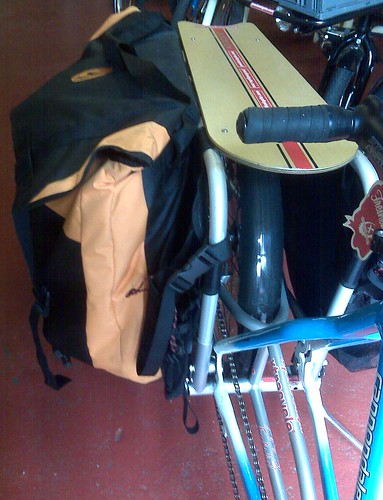
"New York is a great biking city," said Mike Sandmel last night while instructing me and and about a dozen undergraduates about NYU's fledgling pilot program to make a beachhead for bicycle sharing in NewYork City. From their blank-faced stares, I couldn't tell if the undergraduates believed Sandmel -- a junior at NYU's Gallatin school-- but I sure did. Since I last lived in New York a bit more than a decade ago, the City government has revolutionized bicycling in New York by installing bike lanes and, more importantly, by raising the consciousness of New York's famously aggressive drivers that they haveto share the rode with human-powered machines.
So, I was anxious to take out one of NYU's bikes for a free spin on these newly bicycle-friendly streets to see what it was like, which I did this afternoon. NYU's program isn't as high tech as Paris' famous bicycle sharing program and some programs at American universities, so there was no electronic card swiping system or anything like that. But like those higher-tech programs, NYU's bikes don't have to be returned at the same place you pick them up -- you can return them at any other NYU bike sharing location, all eight of which are located in the lobby of one of NYU's dorms.
So, that's where I started this afternoon. They gave me a helmet, a key to the bicycle's lock and told me where the bike -- one of NYU's current fleet of 30 Biria one-speed cruser bikes-- was parked. The bike took a little getting used to -- I'm more used to having 27 or so speeds, and, more importantly, the bike has coaster brakes, which means you stop by pushing backwards on the pedals. I kept trying to stop by squeezing the handle bars -- but this was a futile effort! But it was so exciting to be out on Manhattan streets in the beautiful fall weather. With no destination in mind, I headed east on 4th street, eventually ending up at the East River. There, I turned south along the water all the way to the lower tip of Manhattan -- where I got great views of both tourists and Miss LIberty herself -- and then turned back north along the West Side.
I was impressed by the quality of the bike signage on the way. On the southbound leg, there were signs for the turnoffs for both the Manhattan and the Brooklyn bridges. As I headed up Greenwich Street, there was a (bicycles') sign for the East Side, which directed me to head east on Clarkson and Carmine, which took me almost all the way back to NYU.
The NYU program is part of NYU's sustainability program. It's open to all NYU students, faculty and staff, and started this past summer on the initiative of students like Sandmel. He says he hopes to get a senior grant this year that would allow the fleet to expand to 60.
There's been some growing pains. While a bike has yet to be stolen (something that is inevitable in the nation's bike-stealing capital, says Sandmel), bike lights and bells have fallen victim to theft and weather. The single speed and the coaster brakes make for a very tough, low maintenance bike, however. The organizers had tried to set up a reservations system, but that didn't work -- people just didn't show up, said Sandmel.
It was such a thrill to be out in New York on two wheels, today. It really gave me a sense of freedom to be able to see Miss Liberty and all the other waterfront sights without having to make a large effort. I hope that someday New York will have a city-wide bike sharing program on the kind of scale Paris has, but I'm so glad to be a part of this little start NYU has made by setting up New York's first bike sharing program. Thanks to Sandmel and others who made this possible!











































